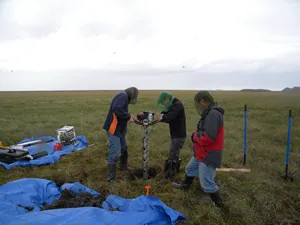As Arctic temperatures rise, permafrost will thaw, releasing greenhouse gases that will accelerate the warming of the planet. But how much or how quickly is not well understood. In an editorial piece published today in the journal Nature, NSIDC scientist Kevin Schaefer joins a group of forty-one international experts working to pin down that number.
The researchers calculate that permafrost thaw will have a greater effect on climate than previous modeling studies have predicted. Arctic soil is thought to hold around 1,700 billion tons of organic carbon, around four times more than all the carbon ever emitted by modern human activity and twice as much as is currently in the atmosphere. As the Arctic warms, the frozen soil thaws and microbes begin to break down frozen plant and animal matter, releasing carbon dioxide and methane into the atmosphere.
In this paper, researchers in a group called the Permafrost Carbon Network predicted how much of the permafrost is likely to thaw, how much carbon that will release, and how much of that carbon will be in the form of methane, which has a much greater effect on warming than carbon dioxide. Their collective estimate is that the amount of carbon released by 2100 will be 1.7 to 5.2 times greater than reported in several recent modeling studies.
The editorial is available at http://www.nature.com/nature/journal/v480/n7375/full/480032a.html.
Contact
Kevin Schaefer
+1 303.492.8869
kevin.schaefer@nsidc.org
NSIDC press office
+1 303.492.1497
press@nsidc.org
To keep track of news from NSIDC, follow us on Twitter (@nsidc) or find us on Facebook.
